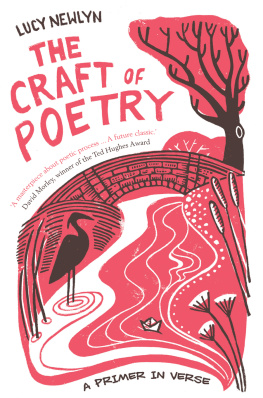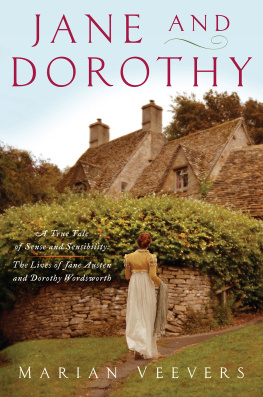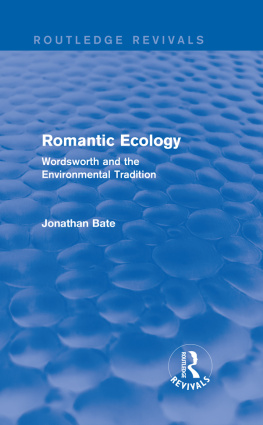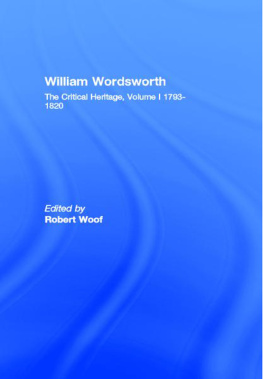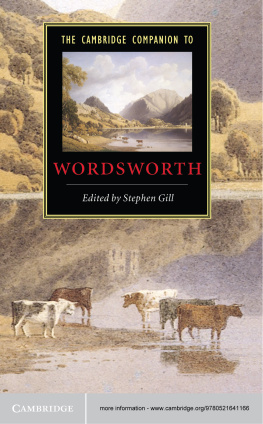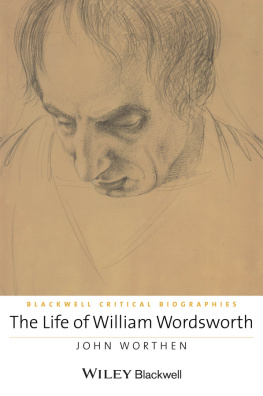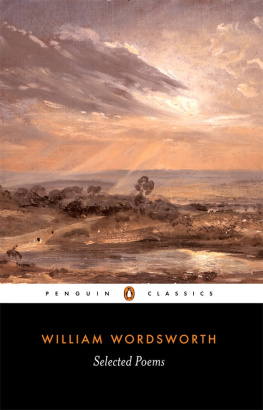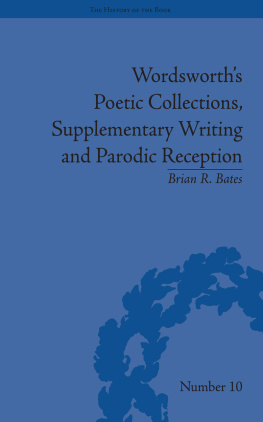WILLIAM AND DOROTHY
WORDSWORTH
WILLIAM AND DOROTHY
WORDSWORTH
ALL IN EACH OTHER

LUCY NEWLYN


Great Clarendon Street, Oxford, OX2 6DP,
United Kingdom
Oxford University Press is a department of the University of Oxford.
It furthers the Universitys objective of excellence in research, scholarship,
and education by publishing worldwide. Oxford is a registered trade mark of
Oxford University Press in the UK and in certain other countries
Lucy Newlyn 2013
The moral rights of the author have been asserted
First Edition published in 2013
Impression: 1
All rights reserved. No part of this publication may be reproduced, stored in a retrieval system, or transmitted, in any form or by any means, without the prior permission in writing of Oxford University Press, or as expressly permitted by law, by licence or under terms agreed with the appropriate reprographics rights organization. Enquiries concerning reproduction outside the scope of the above should be sent to the Rights Department, Oxford University Press, at the address above
You must not circulate this work in any other form and you must impose this same condition on any acquirer
Published in the United States of America by Oxford University Press
198 Madison Avenue, New York, NY 10016, United States of America
British Library Cataloguing in Publication Data
Data available
ISBN 9780199696390
Printed in Great Britain by
CPI Group (UK) Ltd, Croydon, CR0 4YY
For Pamela Woof
Witness thou
The dear companion of my lonely walk,
My hope, my joy, my sister, and my friend,
Or something dearer still, if reason knows
A dearer thought, or in the heart of love
There be a dearer name
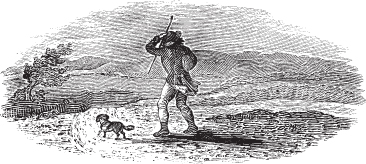
Contents
This book has been gestating for many years. I was encouraged to write it by Andrew McNeillie when he was editor at Oxford University Press. His successor, Jacqueline Baker, has been tremendously supportivereading the book at several stages in its evolution, and giving careful, detailed feedback. A number of colleagues commented helpfully on early plans: Sharon Achinstein, John Barnard, Clare Hutton, Basil Kouvaritakis, Sally Mapstone, Seamus Perry, Steve Roberts, Fiona Stafford, Nicola Trott, Neil Vickers, and Wes Williams. I am very grateful to Stephen Gill, David Fairer, and Tim Fulford, all of whom read draft proposals and/or chapters; to the readers for the Press who made several excellent suggestions; and to Sandie Byrne, who gave up valuable time to comment on the final draft. I learnt a great deal about methods and approaches to biography from helping Hermione Lee and Roy Foster to teach an undergraduate course on Life-Writing in the English Faculty at Oxford. I am also grateful to the graduate students who have attended my course on Romantic Autobiography over the years: their interest and engagement have been perpetually stimulating.
Jeff Cowton, Curator of the Wordsworth Collection at Grasmere, has gone out of his way to help with queries; and with his inimitable patience and enthusiasm has helped me to find appropriate illustrations. Iain Bain very kindly went to the trouble of ensuring that reproductions of Bewicks woodcuts would be of the highest quality: I am very grateful to him for his guidance, as well as to Chris Verraes who undertook the scanning. Tom Clucas has been a model research assistant, photocopying vast amounts of material, patiently checking my quotations and references, and proof-reading the book in its final stages. Many thanks, also, to the team at OUP who have taken care of editing, proof-reading, marketing, and publicity. They have all been great to work with.
I am grateful to the Principal and Fellows of St Edmund Hall for a period of sabbatical leave, which enabled me to complete a first draft. Part of the book grew out of a plenary lecture delivered at the Conference on Creativity in Leeds University in !2008. I thank the editors of Journal for Eighteenth-Century Studies and of Essays in Criticism for permission to reprint portions of arguments that have appeared in a slightly different form elsewhere. My thanks go to the Trustees of the Wordsworth Trust, Grasmere, for permission to reproduce paintings and photographs.
A more personal thank you to Martin and Emma, who have patiently put up with the making of this book since I began to write it in 2009. Last but not least, I would like to thank Pamela Woof, whose knowledge of Dorothy Wordsworths writings is second to none. My typescript was submitted to OUP before reading her remarkable book Dorothy Wordsworth: Wonders of the Everyday, written to accompany the Wordsworth Trusts exhibition of March 2013January 2014. Nonetheless, her scholarship has been an inspiration. I dedicate my book to Pamela, in friendship and with gratitude for all that she has taught me over the years in her writing and conversation.

I have at all times a deep sympathy with those who know what fraternal affection is. It has been the building up of my being, the light of my path.
*
Separated from William and Dorothy Wordsworth in December 1798the year of the Lyrical BalladsColeridge wrote to his friends, You have all in each other, but I am lonely, and want you. In this book, however, I am interested in the siblings cohabitation as evidence of their intense emotional and spiritual need, which arose out of circumstances unique to their family history.
Born in Cumberland, and parted when Dorothy was six years old by the death of their mother, the Wordsworths grew up separatelynot even meeting when their father died, leaving them destitute. They were briefly reunited as adolescents, but saw each other only intermittently in the 1790s. During this time, William attended university, travelled abroad in Europe, became involved in radical politics, and fathered an illegitimate child in post-revolutionary France. He was prevented by complex circumstances from living The long collaborative life of writing they enjoyed in Westmorland enabled them to repay their shared debt of gratitude to the Lake District for providing them with a permanent dwelling. Several tragedies beset them, but their collaborative efforts to rebuild their scattered familys regional identity proved successful. Walking, talking, remembering, and grieving were as important to their relationship as writing; and at every stage of their adult lives they drew nourishment from their immediate surroundings.
The Wordsworths responses to each other, their local community, and the Lake District have proved of outstanding importance, shaping the observations and imaginings of generations of readers, writers, and nature-lovers. Among the thousands of people who make the pilgrimage to Dove Cottage each year, many stop to buy a copy of Dorothys Grasmere and Alfoxden Journals alongside an edition of her brothers poems. Pamela Woofs edition of these two famous journals pays scrupulous attention in editorial notes to the circumstances and chronology of composition, and has made a signal contribution to our understanding of the Wordsworths shared life. In addition, her book



